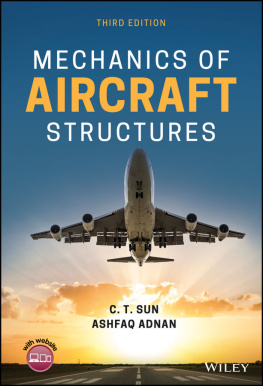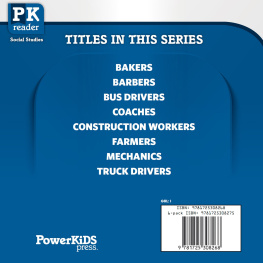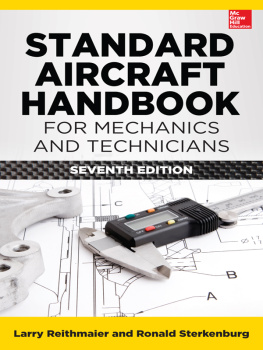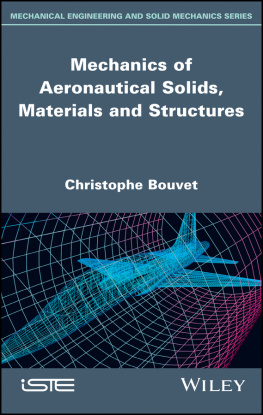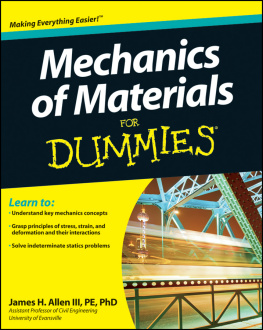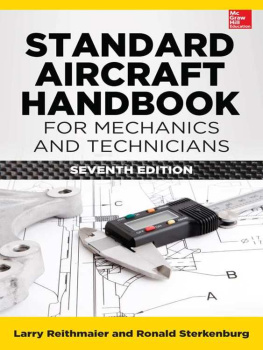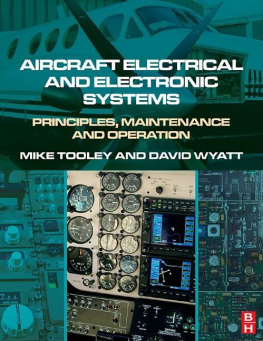C. T. Sun - Mechanics of Aircraft Structures
Here you can read online C. T. Sun - Mechanics of Aircraft Structures full text of the book (entire story) in english for free. Download pdf and epub, get meaning, cover and reviews about this ebook. year: 2021, publisher: Wiley, genre: Children. Description of the work, (preface) as well as reviews are available. Best literature library LitArk.com created for fans of good reading and offers a wide selection of genres:
Romance novel
Science fiction
Adventure
Detective
Science
History
Home and family
Prose
Art
Politics
Computer
Non-fiction
Religion
Business
Children
Humor
Choose a favorite category and find really read worthwhile books. Enjoy immersion in the world of imagination, feel the emotions of the characters or learn something new for yourself, make an fascinating discovery.
- Book:Mechanics of Aircraft Structures
- Author:
- Publisher:Wiley
- Genre:
- Year:2021
- Rating:3 / 5
- Favourites:Add to favourites
- Your mark:
- 60
- 1
- 2
- 3
- 4
- 5
Mechanics of Aircraft Structures: summary, description and annotation
We offer to read an annotation, description, summary or preface (depends on what the author of the book "Mechanics of Aircraft Structures" wrote himself). If you haven't found the necessary information about the book — write in the comments, we will try to find it.
Mechanics of Aircraft Structures — read online for free the complete book (whole text) full work
Below is the text of the book, divided by pages. System saving the place of the last page read, allows you to conveniently read the book "Mechanics of Aircraft Structures" online for free, without having to search again every time where you left off. Put a bookmark, and you can go to the page where you finished reading at any time.
Font size:
Interval:
Bookmark:
- Chapter 1
- Chapter 7
- Chapter 8
- Chapter 1
- Chapter 2
- Chapter 3
- Chapter 4
- Chapter 5
- Chapter 6
- Chapter 7
- Chapter 8
- Chapter 9
THIRD EDITION
C. T. Sun and Ashfaq Adnan

This edition first published 2021
2021 John Wiley and Sons, Inc.
Edition history
John Wiley & Sons, Inc (2e, 2006; 1e 1998)
All rights reserved. No part of this publication may be reproduced, stored in a retrieval system, or transmitted, in any form or by any means, electronic, mechanical, photocopying, recording or otherwise, except as permitted by law. Advice on how to obtain permission to reuse material from this title is available at http://www.wiley.com/go/permissions.
The right of C.T. Sun and Ashfaq Adnan to be identified as the authors of this work has been asserted in accordance with law.
Registered Office
John Wiley & Sons, Inc., 111 River Street, Hoboken, NJ 07030, USA
Editorial Office
111 River Street, Hoboken, NJ 07030, USA
For details of our global editorial offices, customer services, and more information about Wiley products visit us at HYPERLINK "http://www.wiley.com" www.wiley.com.
Wiley also publishes its books in a variety of electronic formats and by print-on-demand. Some content that appears in standard print versions of this book may not be available in other formats.
Limit of Liability/Disclaimer of Warranty
In view of ongoing research, equipment modifications, changes in governmental regulations, and the constant flow of information relating to the use of experimental reagents, equipment, and devices, the reader is urged to review and evaluate the information provided in the package insert or instructions for each chemical, piece of equipment, reagent, or device for, among other things, any changes in the instructions or indication of usage and for added warnings and precautions. While the publisher and authors have used their best efforts in preparing this work, they make no representations or warranties with respect to the accuracy or completeness of the contents of this work and specifically disclaim all warranties, including without limitation any implied warranties of merchantability or fitness for a particular purpose. No warranty may be created or extended by sales representatives, written sales materials or promotional statements for this work. The fact that an organization, website, or product is referred to in this work as a citation and/or potential source of further information does not mean that the publisher and authors endorse the information or services the organization, website, or product may provide or recommendations it may make. This work is sold with the understanding that the publisher is not engaged in rendering professional services. The advice and strategies contained herein may not be suitable for your situation. You should consult with a specialist where appropriate. Further, readers should be aware that websites listed in this work may have changed or disappeared between when this work was written and when it is read. Neither the publisher nor authors shall be liable for any loss of profit or any other commercial damages, including but not limited to special, incidental, consequential, or other damages.
Library of Congress CataloginginPublication Data Applied for:
ISBN: 9781119583912
Cover Design: Wiley
Cover Image: guvendemir/iStock/Getty Images Plus
To my wife, Iris, and my children, Edna, Clifford, and Leslie C.T. Sun
To my loving parents Afroza Nasreen and Dr. Md. Golbar Hussain, my beautiful wife, Most, and my sons, Aayan and Aayat A. Adnan
The purpose of the third edition is to correct some typographical errors in the second edition, add 3D elasticity equations, describe methods for structural idealization, and add a number of worked out and exercise problems. The , a new discussion is added to describe structural idealizations. New example problems are added. The expansions in the remaining chapters are concentrated on new examples and exercise problems.
The authors are indebted to many students and colleagues for some corrections and valuable suggestions. In particular, Ashfaq Adnan is indebted to his former colleague late Dr. Wen Chan. Ashfaq Adnan is thankful to Aayan Adnan for his assistance in making many new drawings. Ms. Rajni Chahal and Dr. WeiTsen (Eric) Lu are acknowledged for their contributions in the workedout problems and instruction materials.
The purpose of the second edition is to correct a number of typographical errors in the first edition, add more examples and problems for the student, and introduce a few new topics, including primary warping, effects of boundary constraints, SaintVenants principle, the concept of shear lag, the Timoshenko beam theory, and a brief introduction to the effect of plasticity on fracture. All these additions are direct extensions of the existing contents in the first edition. Consequently, the backgroundbuilding chapters, and amount to about a 25% increase in the number of pages.
The author is indebted to many students and colleagues for numerous corrections and valuable suggestions. He is indebted also to Dr. G. Huang for his assistance in making many new drawings.
This book is intended for junior or senior level aeronautical engineering students with a background in the first course of mechanics of solids. The contents can be covered in a semester at a normal pace.
The selection and presentation of materials in the course of writing this book were greatly influenced by the following developments. First, commercial finite element codes have been used extensively for structural analyses in recent years. As a result, many simplified ad hoc techniques that were important in the past have lost their useful roles in structural analyses. This development leads to the shift of emphasis from the problemsolving drill to better understanding of mechanics, developing the students ability in formulating the problem, and judging the correctness of numerical results. Second, fracture mechanics has become the most important tool in the study of aircraft structure damage tolerance and durability in the past thirty years. It seems highly desirable for undergraduate students to get some exposure to this important subject, which has traditionally been regarded as a subject for graduate students. Third, advanced composite materials have gained wide acceptance for use in aircraft structures. This new class of materials is substantially different from traditional metallic materials. An introduction to the characteristic properties of these new materials seems imperative even for undergraduate students.
In response to the advent of the finite element method, consistent elasticity approach is employed. Multidimensional stresses, strains, and stressstrain relations are emphasized. Displacement, rather than strain or stress, is used in deriving the governing equations for torsion and bending problems. This approach will help the student understand the relation between simplified structural theories and 3D elasticity equations.
The concept of fracture mechanics is brought in via the original Griffiths concept of strain energy release rate. Taking advantage of its global nature and its relation to the change of the total strain energies stored in the structure before and after crack extension, the strain energy release rate can be calculated for simple structures without difficulty for junior and senior level students.
Font size:
Interval:
Bookmark:
Similar books «Mechanics of Aircraft Structures»
Look at similar books to Mechanics of Aircraft Structures. We have selected literature similar in name and meaning in the hope of providing readers with more options to find new, interesting, not yet read works.
Discussion, reviews of the book Mechanics of Aircraft Structures and just readers' own opinions. Leave your comments, write what you think about the work, its meaning or the main characters. Specify what exactly you liked and what you didn't like, and why you think so.

